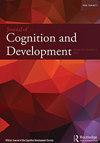检查在尺寸标签理解和生产过程中的神经动力学作为尺寸注意的函数
IF 2.1
2区 心理学
Q3 PSYCHOLOGY, DEVELOPMENTAL
引用次数: 0
摘要
先前的研究表明,儿童标记视觉特征(如“红色”)和维度(如“颜色”)的能力会影响对视觉维度的注意。本研究的目的是探讨支持维度标签理解和产生的神经系统质量的变化与儿童维度注意技能的关系。本研究从田纳西州东部地区招募了3- 4岁的儿童,让他们完成颜色标签的维度标签任务,同时记录功能性近红外光谱(fNIRS),以测量左额叶、左顶叶和左颞叶皮层先前与维度注意力有关的血流动力学变化。采用维度启动任务(测量注意稳定性)、维度变化卡排序任务(测量灵活维度注意)、三联分类任务(测量选择性注意)和匹配任务(测量维度理解)对维度注意的不同方面进行评价。维度标签学习使用颜色生产和颜色理解任务进行测量。结果表明,在维度标签任务中,颞叶皮层被激活。此外,我们发现在维度标签任务中,顶叶皮层的激活增加,在维度注意任务中表现更好。另一方面,在维度标签任务中,颞叶皮层和腹外侧前额叶皮层的激活减少,在维度注意任务中表现较好。这些结果表明,维度注意技能可以揭示支持维度标签学习的神经表征质量的变化。披露声明作者未报告潜在的利益冲突。数据可用性声明支持本研究结果的数据可应要求从通讯作者处获得。本文章由计算机程序翻译,如有差异,请以英文原文为准。
Examining Neural Dynamics During Dimensional Label Comprehension and Production as a Function of Dimensional Attention
ABSTRACTPrevious research suggests that children’s ability to label visual features (e.g. “red”) and dimensions (e.g. “color”) impacts attention to visual dimensions. The goal of this study is to investigate variations in the quality of the neural system supporting dimensional label comprehension and production in relation to children’s dimensional attention skills. The current study recruited 3- to 4-year-old from the East Tennessee area to complete dimensional label tasks for color labels while recording functional near-infrared spectroscopy (fNIRS) in order to measure hemodynamic changes in left frontal, left parietal, and left temporal cortices previously implicated in dimensional attention. Different aspects of dimensional attention were evaluated using the dimensional priming task (measuring attentional stability), the dimensional change card sort (DCCS) task (measuring flexible dimensional attention), the triad classification task (measuring selective attention), and the matching task (measuring dimensional understanding). Dimensional label learning was measured using a color Production and color Comprehension task. Results indicated that the temporal cortex was activated during the dimensional label tasks. Further, we found that activation in parietal cortex during the dimensional label tasks increased with better performance on the dimensional attention tasks. On the other hand, activation in the temporal cortex and ventrolateral prefrontal cortex during the dimensional label tasks decreased with better performance on the dimensional attention tasks. These results suggest that dimensional attention skills can reveal variations in the quality of neural representations supporting dimensional label learning. Disclosure statementNo potential conflict of interest was reported by the author(s).Data availability statementThe data that support the findings of this study are available from the corresponding author upon request.
求助全文
通过发布文献求助,成功后即可免费获取论文全文。
去求助
来源期刊

Journal of Cognition and Development
Multiple-
CiteScore
4.00
自引率
0.00%
发文量
29
期刊介绍:
The Journal of Cognition and Development is the official journal of the Cognitive Development Society (CDS). Some CDS members are concerned with basic research or theory; others focus on policy issues and practical applications. The range of interests includes cognitive development during all stages of life, and we seek to understand ontogenetic processes in both humans and nonhumans. Finally, their interests encompass typical as well as atypical development, and we attempt to characterize both biological and cultural influences on cognitive change and continuity.
 求助内容:
求助内容: 应助结果提醒方式:
应助结果提醒方式:


